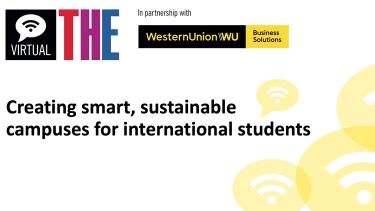By maintaining and strengthening the creative solutions that were employed during the pandemic, US institutions can support international students and explore new opportunities to attract talent
US universities should persist with the innovations and advancements that were accelerated by the Covid-19 pandemic in order to remain appealing to international students.
A recent THE Live US event, held in partnership with Western Union Business Solutions, highlighted the challenges and opportunities for international study to effectively coexist with digital transformation.
Mary McKey, head of corporate and foundation programmes at the Institute of International Education, said that the pandemic had accelerated the move to blended and hybrid models of learning and teaching.
McKey said a survey of institutions in the autumn semester found 92 per cent were teaching “in a way that was unlike any semester previously”.
“This is really providing an opportunity for them to explore different methods of instruction and different types of technology for instruction,” she said.
The survey found that about 20 per cent of international students enrolled in US higher education were based abroad. While they were generally happy with virtual classes, the sudden shift to online presented “some really profound logistical and infrastructure challenges”.
These included learning across different time zones, accessing campus services and technology and, especially in multigenerational households, finding a quiet space to study.
McKey said that the vast majority of universities had offered priority tech support to international students and many had made efforts to maintain the social aspects of studying.
Rajiv Sharma, head of education for North America at Western Union Business Solutions, said that initiatives such as Columbia University’s nine global centres offered international students a sense of the campus community.
“It’s a network to allow students to actually be in the same premises…whether it’s for the socialising or connectivity to internet or access to hardware, like a printer,” he said.
With many students feeling financial strain from the pandemic, there was also a need to accelerate the digitalisation of financial instruments, allowing those in their home countries to access refunds or university emergency response funds.
International students contribute about $44 billion (£32 billion) to the US economy and, McKey said although the pandemic had brought plenty of “pain points”, it had also sparked imaginative solutions.
“The great news is that we’re seeing universities and the higher [education] community really respond in creative ways to ensure that international students continue to feel connected to their home institutions,” she said.
She concluded: “I think some of these innovations and these things that we’ve had to do will actually be really great models for moving forward into the future.”
Watch the session on demand above or on the THE Connect YouTube channel.
Find out more about Western Union Business Solutions and higher education.




